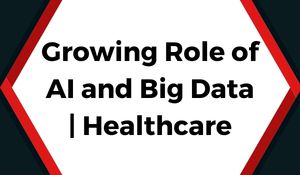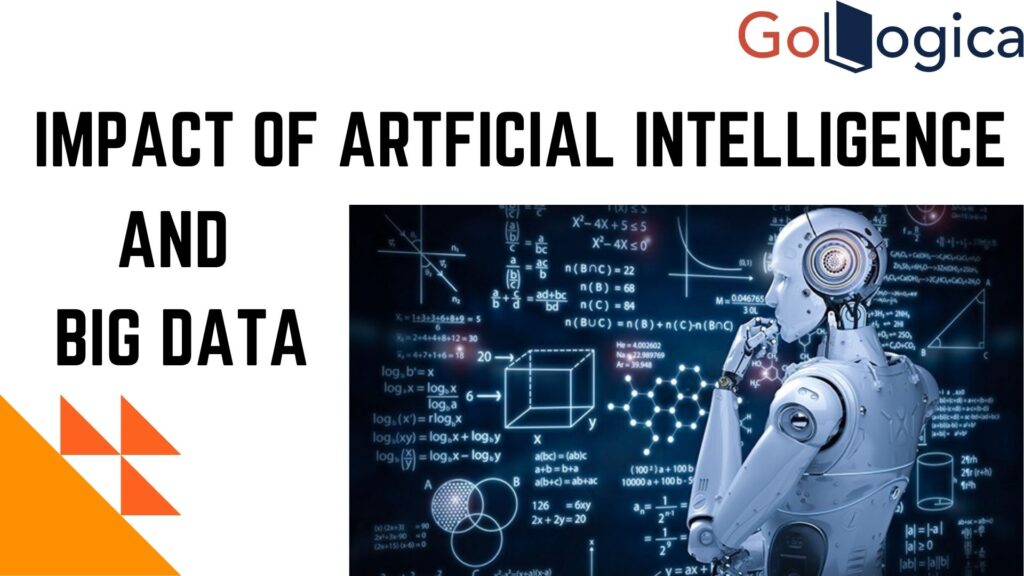
As technology evolves, so does the role of artificial intelligence (AI) and big data in healthcare. As a result, both AI and big data are playing an increasingly important role in diagnostics, treatment planning, and post-treatment care. This blog post will explore how AI and big data are changing healthcare for the better.
Every year, AI is becoming more ingrained in working and living. From our smartphones to smart speakers, AI is making it easier for us to communicate with technology regularly. Other industries are beginning to notice this trend as well. Many have taken note of the growth potential that artificial intelligence offers; some are even adapting some of their practices or services around it. Now one field that’s become increasingly reliant on AI in health care. Artificial Intelligence vs. Big Data
One challenge posed by modern medicine is its complexity. According to research from IBM, there were 1.8 million biomedical articles published last year alone! This means that sifting through all existing research on a specific topic can be a huge undertaking. It’s no wonder researchers from the Johns Hopkins University School of Medicine stated in an article for Nature that “We have entered the data-intensive biomedical era, driven by high-volume, diverse and complex omics [types of data] types.” So while there is more research being published than ever before, sorting through all the information becomes exponentially more difficult. Because of this growing concern around quickly sifting through data, many healthcare professionals have turned to AI for help.

Real-time Example:
One example of how AI is used in healthcare involves diagnosing lung cancer. This process typically requires radiologists to look at CT scans and spot small nodules or masses that indicate the disease. However, it’s not as simple as it sounds. It’s not uncommon for radiologists to sometimes miss some nodules, and even when they don’t, there is the possibility that the masses could be something unrelated to cancer (such as an infection). All of these false positives can cause unnecessary worry in patients and leave physicians potentially missing crucial information.
One way that AI might improve things is by using deep learning algorithms. These types of AIs work through a technique called “training.” At its core, training means exposing the system/algorithm to data to learn how to recognize patterns or signals among them. So, for example, if you train an algorithm with thousands of X-rays of lung cancer patients, it will recognize common features of the disease. It can even learn what to look for when it’s not sure.
This is different from older artificial intelligence methods, where programmers would have to preselect features for the algorithm to hone in on. For example, if you wanted an AI to differentiate between dogs and cats, then you’d select traits that are characteristic of each animal (hind legs for dogs; whiskers/shedding fur for cats). Over time this type of training improves an AI’s results, but it also limits how well the system interacts with new data sets.
What are the Benefits of AI and Big Data In Healthcare?
Artificial intelligence (AI) and Big Data are two fields that have taken the healthcare world by storm. As experts in both AI and big data, we believe it is important to understand their benefits for the industry as a whole and what potential they may hold for medical students who choose to pursue careers in medicine.
1. Improving Patient Outcome: With the recent explosion of patient information, healthcare providers can spend less time sifting through raw data and more time interpreting these findings. For example, one study conducted at Stanford University using deep-learning technology was able to predict heart attacks with 90% accuracy with just one EKG reading (versus 70% accuracy with two readings). Other academic institutions are utilizing this data to predict medical events such as sepsis, heart failure, and cancer. In the future, AI technology will be able to consider a patient’s age, genetics, family history, and even lifestyle choices to improve outcomes.
Related Courses
| Course Name | Enroll Now |
|---|---|
| Big Data Architect Masters Program | Enroll Now |
| BIG DATA SPLUNK TRAINING | Enroll Now |
| BIG DATA APACHE FLUME TRAINING | Enroll Now |
| BIG DATA HADOOP TRAINING | Enroll Now |
| Talend Big Data Training | Enroll Now |
2. Shortening Discharge Times: As diagnostic technologies become more advanced and clinical decision support tools become more readily available, physicians will be able to spend less time on data analysis and increased time face-to-face with their patients. The use of medical imaging devices such as MRIs or ultrasounds will allow for easier diagnoses by catching conditions early on when it is most effective to treat them. On the flip side, doctors who have been spending excessive amounts of time sorting through lab results or echocardiograms to assess heart problems will have more time to devote to their patients.
3. Better Disease Monitoring: Big data is being used in the medical field in several ways. Some institutions are using big data to identify patient cohorts with similar symptoms to share relevant information across departments and providers to better monitor these conditions. For example, one research team at Harvard University found that by sharing genomic information between three institutions (a university hospital, a community hospital, and a cancer institute), they specifically targeted treatment options for leukemia patients. Other institutions utilize big data sets to monitor diseases such as Ebola or Zika Virus, which require constant analysis of current trends to make decisions about containment or preventative actions.
4. Early Identification of Hospital Acquired Infections: Some institutions are also using big data to identify hospital-acquired infections (HAIs). For example, one study conducted by Boston Children’s Hospital used de-identified electronic health record (EHR) data to assess HAI’s impact on mortality rates and length of stay for pediatric patients. They found that children with HAIs were nearly two times more likely to die within 30 days than those without them, further evidence that early identification is crucial to improve patient outcomes.
5. Better Patient Compliance: The field of medical informatics has made great strides toward identifying patients who are at risk for non-compliance or readmissions. With big data, researchers can now monitor a patient’s daily health status and detect when there is a deviation in the patient’s regular regimen (such as when they haven’t taken their medication on time). For example, one research team at McLean Hospital in Boston was able to predict near-term readmissions by looking at these deviations in regular behavior. Furthermore, institutions are looking towards voice-recognition technologies or computer vision for nonverbal cues to monitor compliance. This will allow physicians to communicate more effectively with patients during visits and make adjustments when necessary.
6. Improved Accessibility of Health Data: Big data sets can be used to monitor disease outbreaks that may affect certain populations across the country or around the world. For example, one study conducted at Brown University analyzed big data sets from Google News, Twitter, Reddit, and Wikipedia to identify disease outbreaks and detect new cases of influenza up to 10 days earlier than the CDC. Furthermore, big data sets allow institutions and researchers to quickly access information about past epidemics such as Ebola or Zika Virus.
This is crucial considering that those with certain genetic predispositions are more susceptible to contracting these illnesses. For example, some institutions such as Mount Sinai Hospital in New York City have started utilizing specialized software that analyzes health records and uses artificial intelligence (AI) technology to map a patient’s family history and recommend preventative care based on their identified risk factors. This is important because identifying at-risk patients can ensure they receive prompt attention from a physician before a condition worsens.

Conclusion:
The potential for big data and AI to revolutionize healthcare is immense. Already, we are seeing these technologies being used to improve patient care, streamline operations, and cut costs. As these technologies continue to develop, we can only expect more amazing things to be done with them in the world of healthcare. Are you excited about the role of AI and big data in healthcare? What do you think will be its most impactful application?
👉 Related Articles:
🎯 About Big Data vs Internet Of Things
🎯 What is Big Data Analytics? A Complete Guide to Big Data Analytics
🎯 Big Data in Internet Of Things
🎯 What is MapReduce in Big Data?
🎯 Big Data vs Data Science vs Data Analytics
🎯 Detail Information about Big Data in AWS
🎯 Everything You Need To Know-Talend Big Data
🎯 Hadoop Vendors Leading the Big Data
🎯 Big Data solutions for SQL Server
🎯 Streaming Big Data with Apache Spark
🎯 BIG DATA TALEND Interview Questions and Answers
🎯 Big Data Mapreduce Interview Questions and Answers
🎯 Big Data&Hadoop Interview Questions and Answers
Author Bio:
Anji Velagana loves pursuing excellence through writing. He currently writes for Gologica.com, a global leader in providing the best online training to individuals who wish to take training on different abilities. He has experience of 5 years in the field of content writing. Contact him via LinkedIn.

